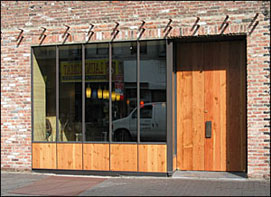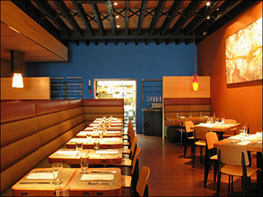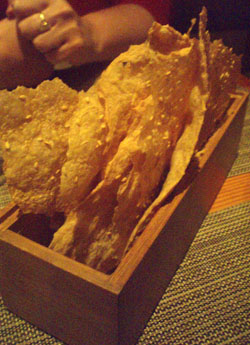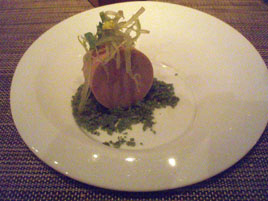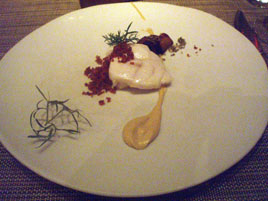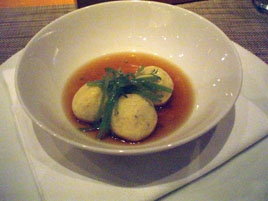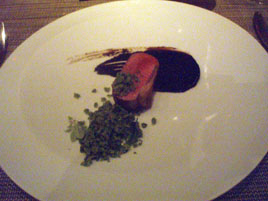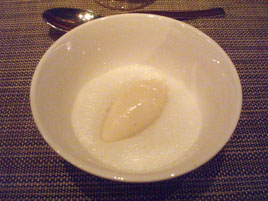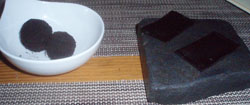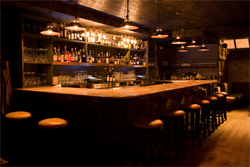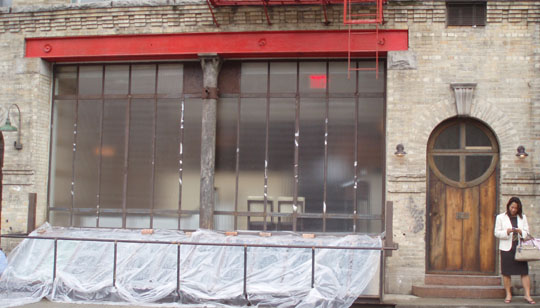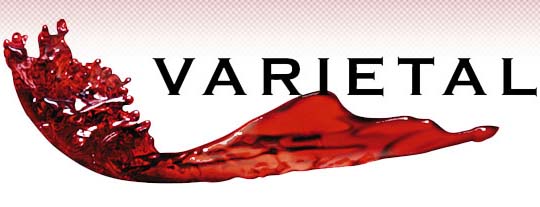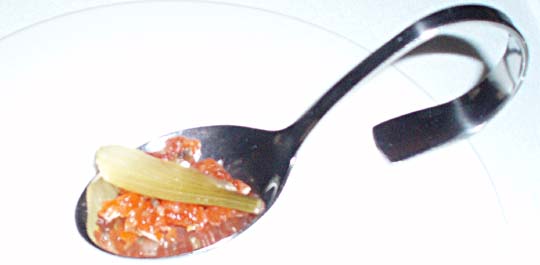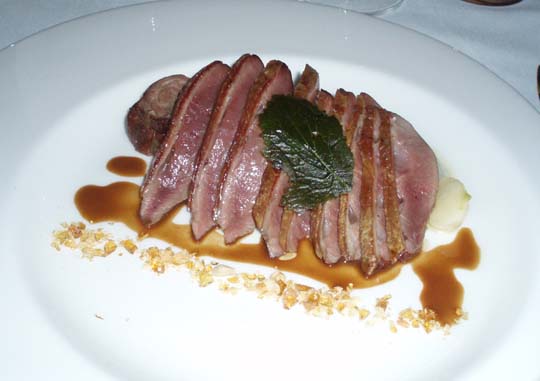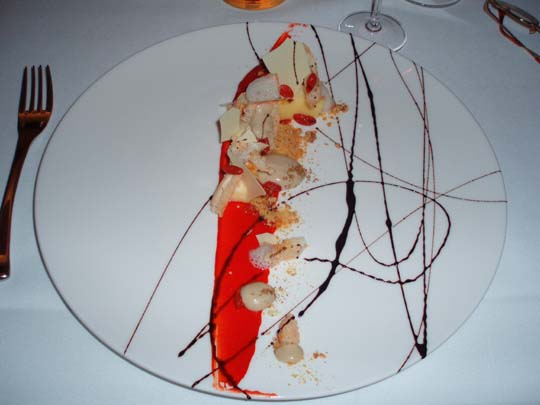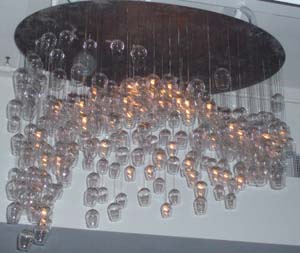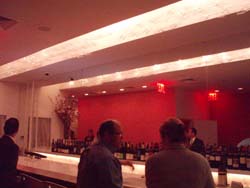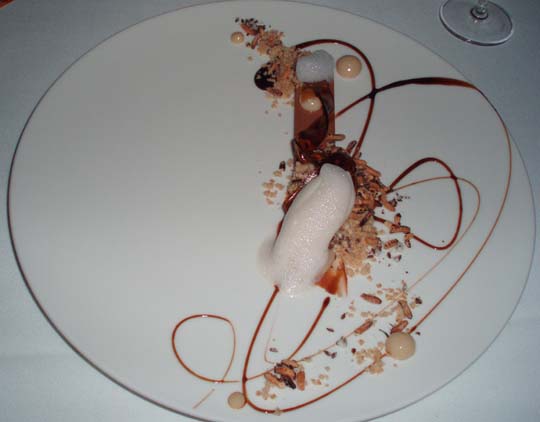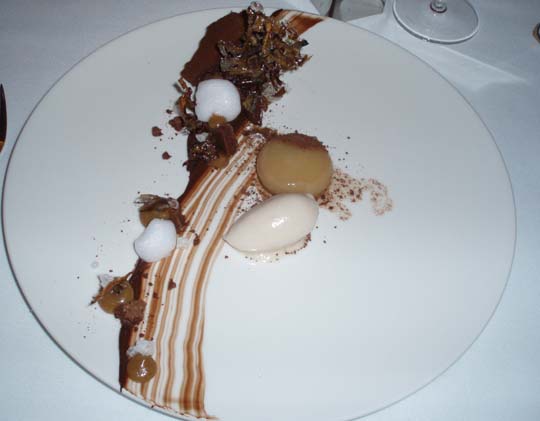
Another New Year’s Eve…what to do? Most restaurants serve a less interesting version of their normal menu, while at least doubling the price. The only exception I’ve found is WD–50, but as we tried that last year, I wanted something different.
Enter Bite Club, the “French Laundry of dinner clubs.” With raves on Grub Street and eGullet, I knew it was for real, and that owners Daniel & Alicia would turn out another of the fantastic menus they’re quickly becoming famous for.
But first, there were a few hurdles. You don’t just call Bite Club for a reservation; you have to become a member. Then, a 50% deposit was due (that’s $200), payable in cash, hand-delivered either to Daniel’s or Alicia’s workplace. Three days before the event, clandestine instructions came by e-mail, cautioning us to “maintain silence” in the apartment building where the dinner was held, until were in the apartment itself. “Should you be in the elevator with someone, it is imperative that you NOT mention Bite Club. Even if you suspect they are fellow diners for the evening, please wait until you are both brought into the apartment to confirm that.” My girlfriend wondered if we should have brought payment in small, unmarked bills.
There are reasons for all of that secrecy, as Bite Club’s operation is something between a restaurant (with all the laws and regulations that implies) and a just dinner party amongst friends. It isn’t quite clear on what side of that line Bite Club falls. Initially, it really was just Daniel and Alicia throwing dinner parties for their friends. It has clearly become something a bit more commercial over time, though the party atmosphere still lurks in the background.
I was surprised at the size of the crowd, as I’d been led to expect somewhere around a dozen guests. There were nearly 30, at tables mostly for 6–7 guests, although there was one two-top. We were seated with a party of four, but we quickly built a rapport and enjoyed our four-hour meal together as if we were old friends. One of Bite Club’s advantages is that you know you’ll be eating with people who really appreciate great food and wines. With Daniel and Alicia serving plenty of both, you won’t lack for conversation.
There were printed menus for everyone, describing both the food and the wines in some detail. Daniel and Alicia’s style is modern, not clearly beholden to any particular cuisine. They relish combining ingredients in unexpected ways. What comes out on the plate is generally spare and uncluttered, though the preparation may well have been complex. Daniel told us they started cooking at 7:00 the night before.
We noted that there were hardly any vegetables on the menu; we weren’t sure whether this was a preference, or if they had reached the limit of what two people could accomplish in such a small space. I don’t know what they have at home—this was not their own place—but we were in a standard Manhattan apartment, with a fairly small kitchen clearly not designed to turn out 7 courses for 30 diners. Assisting were a dish-washer and two servers—the place couldn’t have accommodated any more helpers, even if Daniel and Alicia had wanted them. What they produced was a marvel.
Besides preparing all the food, Daniel and Alicia also have an impressive battery of stemware and china. Given the length of the meal and the number of guests, they needed all of it. As they raise Bite Club to new levels, they might want to consider a small investment in flatware. A few times, we were given utensils that weren’t quite right, or asked to re-use utensils from a previous course. Butter knives would have been helpful. But this was the only small complaint we had, with what was otherwise flawless service.
Dinner was seven courses with paired wines. I wasn’t sure about the etiquette of taking photos, and in any case I didn’t want to risk disrupting such a festive occasion, but check out Off the Broiler if you want to see what some of Daniel and Alicia’s creations look like.
We began with a sparkling Spinetti Moscato d’Asti, followed a short while later with a crazily good amuse-bouche, venison loin with Thai chili and goat cheese. Two breads were served, along with two contrasting spreads, a soft butter and a liver pâté. Soft, warm onion rolls came later.
The first savory course was called Egg (truffled egg custard, vodka cream and caviar), paired with a Casa Ferrienha Esteva 2002. The custard and caviar came inside of a hollowed out egg. The combination was terrific.
Next came Lobster (cream of lobster, black truffle pastry), paired with a Tissot Les Bruyeres 2004. Though described as cream of lobster, there were actually several solid chunks of butter-poached lobster with the pastry on top, in a small dish that you’d normally use for crème brûlée. The presentation didn’t quite work, as you couldn’t really navigate your knife inside of the dish to cut the lobster. The wine was a Chardonnay with an unusual smoky flavor.
After that, Sweetbreads (JG raisin caper emulsion and cauliflower puree), paired with Rosenblum Viognier 2005. Three hunks of sweetbread each rested on a dab of cauliflower, with the raisin emulsion splashed between them, in the middle of the plate. The lusciously tender sweetbreads and the cauliflower puree complemented each other perfectly, but we felt that the raisin caper emulsion didn’t really add anything.
The main savory course was titled “Pork & Beans”, a sly name very much in the French Laundry style. Two juicy slices of caramelized pork belly were bathed in a cranberry bean puree and pomegranate reduction, paired with Castell’in Villa Chianti Classico 2003. This was a highlight for everyone at our table, though I have to admit that I’ve hardly ever seen a pork belly dish go wrong: with all of that fat, there is bound to be decadence on the plate.
The Cheese Flight offered five raw (i.e., unpasteurized) cheeses, which I believe Daniel and Alicia import from Canada. There was a contrast of cow, goat, and sheep’s milk cheeses, arrayed in order of increasing intensity. I found one of them a bit dull, but the other four were first-class; overall, it was a well judged selection. The paired wine was Brovia La Brea Barbera 2005.
In perhaps their most daring choice of the evening, as well as the most complex, the last savory course was Foie Gras (also a Canadian import) with poached pear, ginger snap, cacao nibs, and star anise caramel. Foie gras is normally served early in the meal, so I was surprised to find it after the cheese course. But foie gras is a versatile ingredient: serve it with poached pears and caramel, and it becomes a dessert. Brilliant! The paired wine was Rasmussen Late harvest Gewurztraminer 2003.
Midnight approached as the foie gras plates were being cleared, so everyone pitched in to get the champagne poured (Roederer Anderson Valley NV Methode Champenoise), and we counted down the seconds to midnight.
The final course, captioned Chocolate, was the only one that really misfired: a chocolate cake bedecked with a frosted scotch bonnet (a kind of chili pepper). Despite its time in the freezer, the pepper packed serious heat, and I was the only one at my table who ate all of it. It was a four-alarm fire in my mouth, but it felt great afterwards. After that adventure was over with, we were left with a dull mound of chocolate that wasn’t worth eating. After four happy hours and seven wine pours (several with refills), nobody at my table was paying much attention to the chocolate anyway.
The overall quality of the meal approached the level of the better tasting menus in town. Wine pairings were all lovely, and some of them even witty. It is all the more remarkable when you consider that (as I understand it) Daniel and Alicia are self-taught. They also don’t have the advantage of trying everything out in a test kitchen: every meal they serve is unique, based on the ingredients available and their own whims. And in another week or so, they’ll have to go out and do it all again. (Bite Club events are generally on weekends, since Daniel and Alicia have day jobs.)
Daniel and Alicia richly deserve all the accolades that have come their way. They are also gracious and gregarious hosts, and love to talk about the food. I suspect that even greater things are to come, and I hope to be at Bite Club again to enjoy them.
 Tuesday, October 15, 2013 at 04:00PM
Tuesday, October 15, 2013 at 04:00PM 
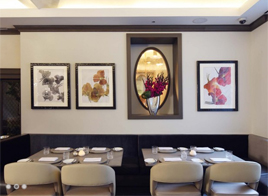
 You’ve got to give Shaun Hergatt credit for persistence, if naught else. His first fine-dining restaurant won two Michelin stars but took a critical drubbing. The critics acted clowns, but the same clowns (or some of them) are still running the circus.
You’ve got to give Shaun Hergatt credit for persistence, if naught else. His first fine-dining restaurant won two Michelin stars but took a critical drubbing. The critics acted clowns, but the same clowns (or some of them) are still running the circus.












